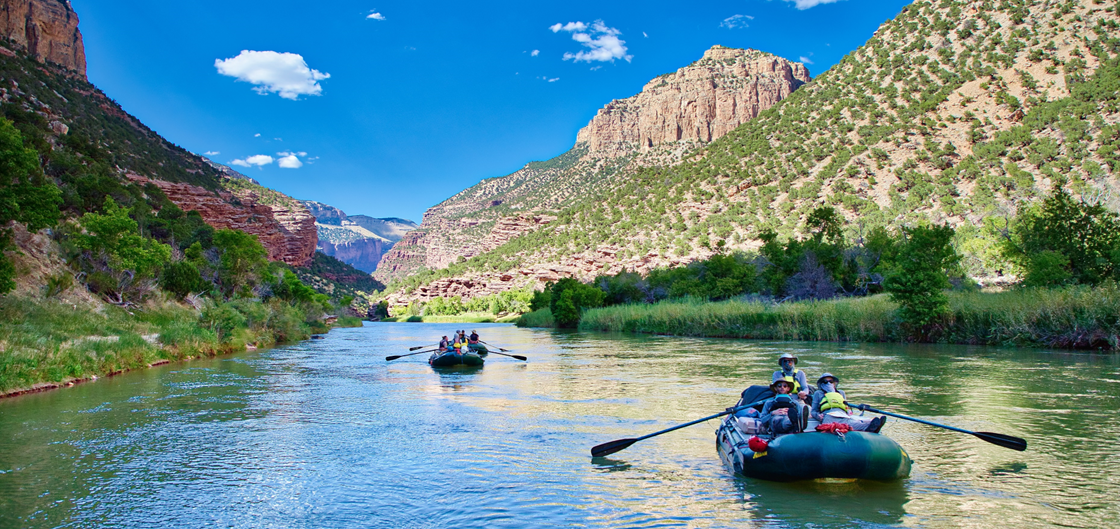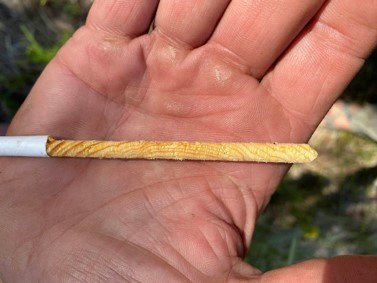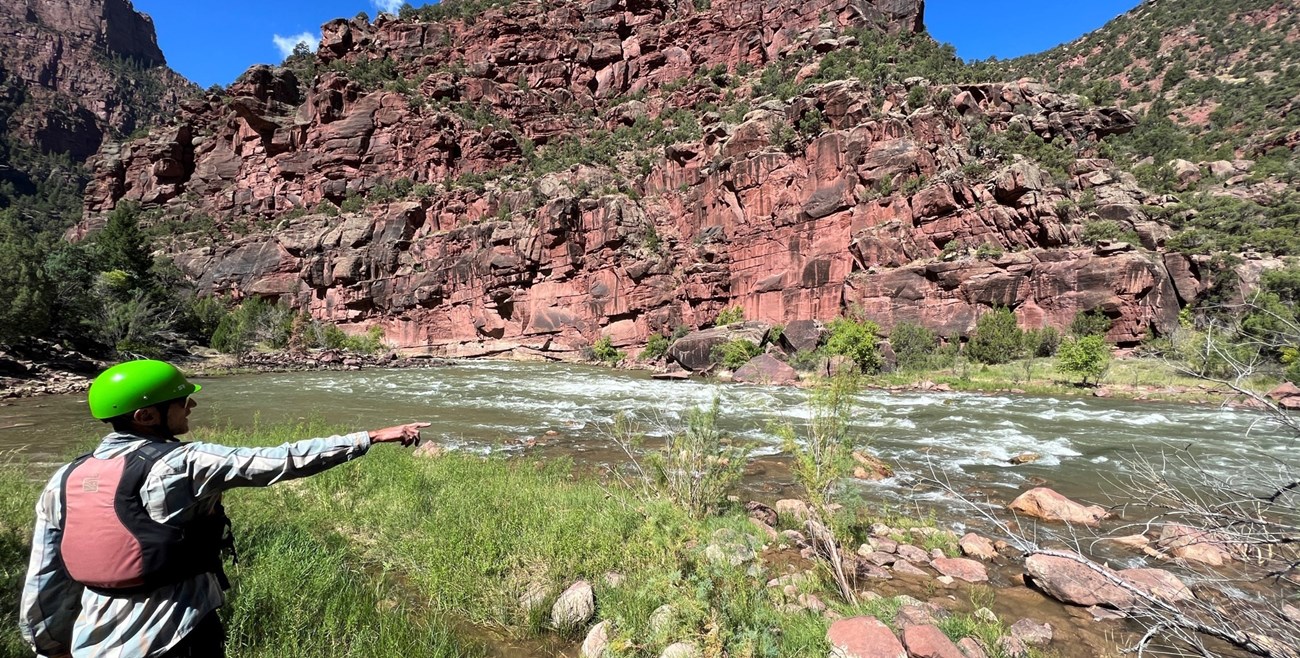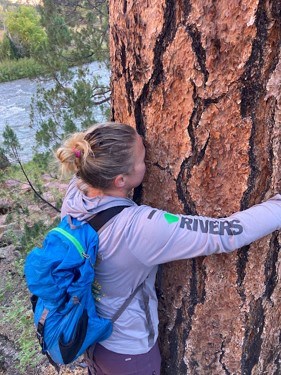Last updated: April 23, 2025
Article
Why I Volunteer: Veteran Supporting Dendrochronology Research at Dinosaur National Monument

Dinosaur National Monument is renowned for its dinosaur fossils and striking geological features. The monument is also home to unique backcountry Volunteers-In-Parks (VIP) opportunities along the scenic Green and Yampa Rivers!
River volunteers play an important role in preserving the monument’s natural and cultural resources. Over the course of almost 30 years, river volunteers have worked closely with park rangers to gather valuable data that supports informed decision-making necessary to preserve the monument’s resources for future generations. Examples of river volunteer projects range from conducting wildlife surveys, habitat restoration, water and air quality studies, archaeology and paleontology inventories, and improving camping sites.

Into the Green and Yampa River Canyons!
From 2022 to 2024, Dinosaur National Monument’s Resource Stewardship and Science team, alongside dedicated VIPs, partnered with the United States Geological Survey (USGS) to conduct summer fieldwork in the Green and Yampa River Canyons.
The team navigated both calm stretches and white-water rapids to map the locations of Ponderosa pine trees, gather detailed measurements of their size—including trunk diameter at breast height, tree height, and crown spread—and collect core samples from individual Ponderosa pine trees growing within the river corridors. This fieldwork was part of a broader dendrochronology study designed to reconstruct historical drought events and changes in river streamflow in the region over the past 300 to 500 years.

What Can Tree Rings Tell Us?
The study of tree rings is known as dendrochronology. As a tree grows, it adds a new ring of wood to the outer edges of its trunk, with the youngest rings located near the edge of the trunk and the oldest rings near the center.
A lighter colored ring forms in the spring and early summer when a tree is growing, whereas darker-colored rings form in the fall and are thinner because the tree grows slower during this time of year. A light and dark-colored ring couple represents one year of growth. Scientists can determine the age of a tree by counting the number of rings, either the light or dark colored ones, from the center to the trunk’s edge!
In addition to helping scientists determine the age of a tree, the changes in the width of an annual ring reflects the variable growing conditions for each year. A narrow annual tree ring usually indicates that the year was drier, while a wider annual tree ring implies a wetter year.

Serving Communities is a Core Element of Jeremy’s Identity
Jeremy’s love for rivers began at a young age, growing up playing in Darby Creek, which ran through his family’s farm in central Ohio. After earning a Bachelor of Science degree in Civil Engineering from The Ohio State University, he served four years of active duty in the United States Army as an Environmental Science Officer, followed by two decades as a software engineer.
Jeremy discovered his passion for volunteerism after moving to Steamboat Springs, Colorado. There, he dedicated 10 years to coaching a youth bike program and spent 12 years volunteering with the non-profit Friends of the Yampa—conducting water sampling, carrying out river cleanups, and helping to host events along the Yampa River.
“I first learned about volunteering for Dinosaur National Monument’s Resource Stewardship and Science river trips in 2021 through a friend. I had been searching for a new opportunity to combine my love of rivers with my eagerness to give back to our public lands, and the Resource Stewardship and Science program felt like a perfect fit”, says Jeremy.
His most profound take away from volunteering with Dinosaur National Monument has been the incredible amount of knowledge he has gained from working along side scientists and park rangers and the infectious enthusiasm that the community brings to science and preservation.
Jeremy shares, “volunteering for these scientific efforts connects me to something larger than myself. It offers me an elevated sense of purpose, knowing I’m in some small way contributing to the preservation of breathtaking landscapes that future generations deserve to experience.”
In addition to his love for collecting data for science, Jeremy finds that volunteering and exploring the backcountry river canyons with his wife of 29 years, Marla Bailey, deepens his connection to the work. It also strengthens their bond through the lasting memories they have created volunteering together.
In July 2024, Jeremy elevated his passion for the Yampa River watershed by joining Friends of the Yampa as a part-time program and office assistant.

Steering Science on the River
“Dinosaur is a medium-sized park with a small park staff and big park complexities. My greatest passion here is facilitating ‘actionable science’ and the resource stewardship that science directs”, says Volunteer Supervisor and Natural Resource Specialist, Emily Spencer.
Emily first arrived at Dinosaur National Monument as a seasonal employee in 2003 to write the invasive plant management plan. After her term ended, she pursued graduate studies. She later returned to northwest Colorado for her first permanent federal job with the Bureau of Land Management, just down the road from Dinosaur National Monument.
Emily jumped at the chance to return to Dinosaur National Monument in 2014 when the Natural Resource Specialist position became vacant. A key part of her role involves recruiting, training, onboarding, and overseeing volunteers, like Jeremy, for the Resource Stewardship and Science River trips.
Emily mentions, “I reviewed the United States Geological Survey’s research application for the Ponderosa pine dendrochronology study and immediately recognized that this project could enhance our understanding of the characteristics of a dam-regulated river, the Green River, an unregulated river, the Yampa River, and the hybrid river formed below the confluence of the Green and Yampa Rivers.”
A personal goal for Emily, as she works with river volunteers, is to connect them with science professionals and provide opportunities for meaningful research in a place they love, thereby strengthening the connection and advocacy volunteers feel for Dinosaur National Monument.

Collecting Ponderosa Pine Core Samples and Measurements
Over the last three summers, Jeremy dedicated 250 hours volunteering in the river canyons of Dinosaur National Monument—rowing 200 miles downriver and helping transport Emily, fellow team members, personal gear, camping supplies, and scientific equipment.
“My favorite part of being a raft operator is watching scientists and other volunteers experience their first multi-day raft trip is incredibly rewarding. There’s a unique blend of awe and adventure, field work and relaxation, solitude and camaraderie—a dynamic that creates an experience unlike any other sort of river trip I’ve been on or a part of. By the final day at the take-out, nearly everyone is eager to go back to the put-in to do it all over again.” says Jeremy.
In addition to safely transporting members, gear, and equipment, Jeremy assisted every aspect of data collection. From his captain's seat, he helped spot Ponderosa pine trees and pulled the raft over to access these trees.
Once he marked the tree on a map, Jeremy used a tape measure to record the trunk diameter at chest height. To measure the tree’s height, he stood at its base and aimed a laser hypsometer up at the top of the canopy. He also learned how to use an increment borer, a hand tool that drills into the tree to pull out a thin core sample. These wooden “time capsules” show the tree’s growth rings, helping the team learn how old the tree is and it’s growing conditions over the years.
Jeremy shares, “locating Ponderosa pines from the raft was such a rewarding experience, especially the effort it took to reach them for core sampling and taking measurements. This hard, often sweaty work encouraged us to pause, step out of the raft, and explore areas that most river runners—including myself—would typically float past, immersing ourselves in the unique, seldom-visited corners of the Monument.”

In total, Jeremy helped the team core and collect measurements of over 120+ Ponderosa pine trees. These cores are now being analyzed under the microscope in a laboratory by USGS scientists to better understand the drought events and streamflow changes of the Green and Yampa Rivers over the last 300-500 years.

Thank you, Jeremy and Volunteers!
“Dinosaur National Monument has a small staff. I get maybe a seasonal or two or an intern every summer. And yet, because of volunteers like Jeremy, we are able to leverage the input of researchers and Dinosaur National Monument staff and get an amazing amount of work accomplished each year.
Each volunteer is enormously skilled in their own way and brings incredible perspective and insight to each project or trip. I learn so much from them! Without question this program improves each year because of the talents volunteers bring to the program” says Emily.
It is thanks to the incredible work of volunteers like Jeremy that Dinosaur National Monument continues to meet its goals and uphold the mission of the National Park Service. Thank you to Jeremy and all our volunteers for the invaluable contributions you make!
